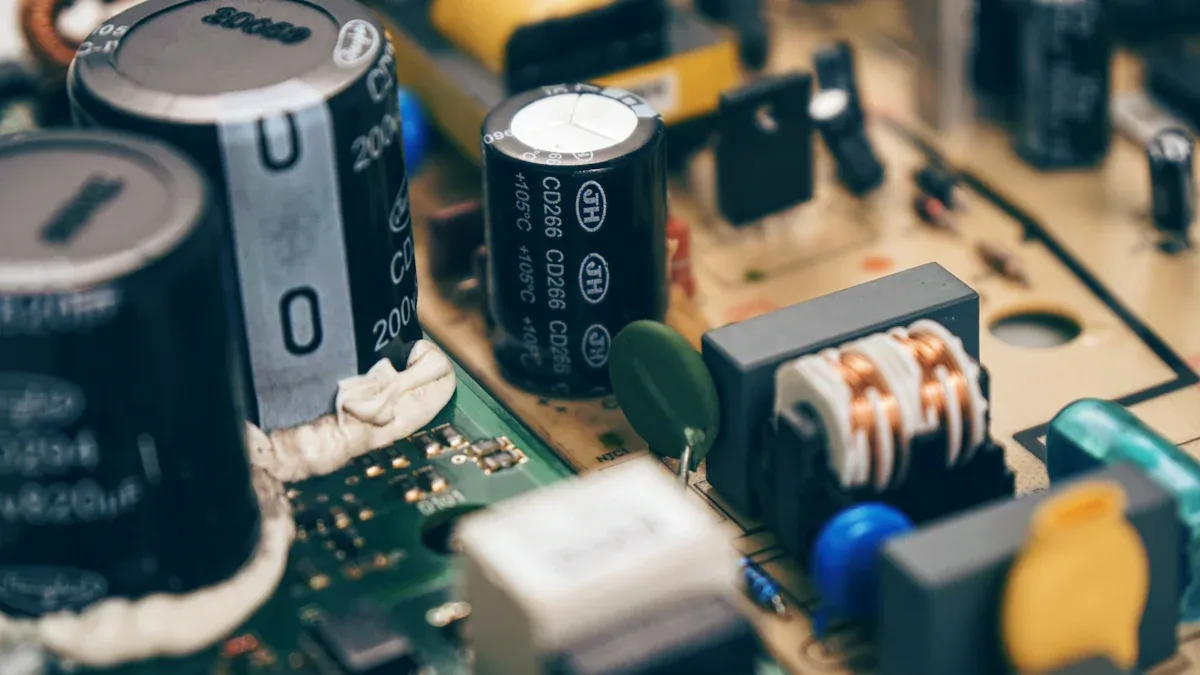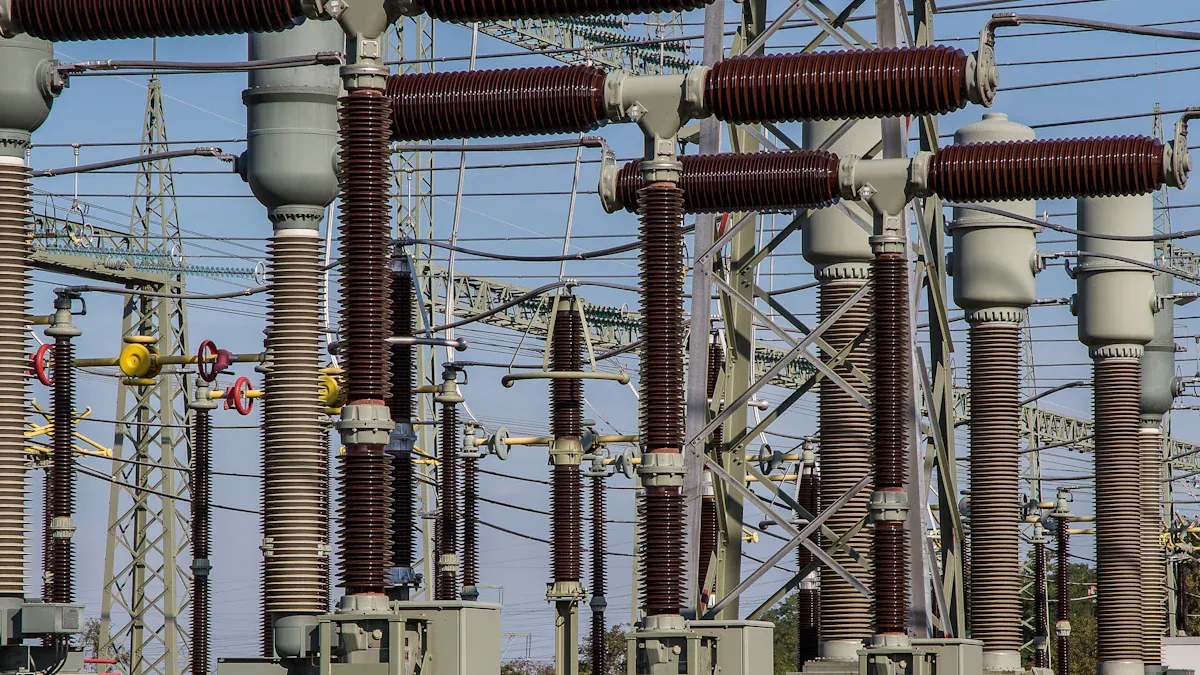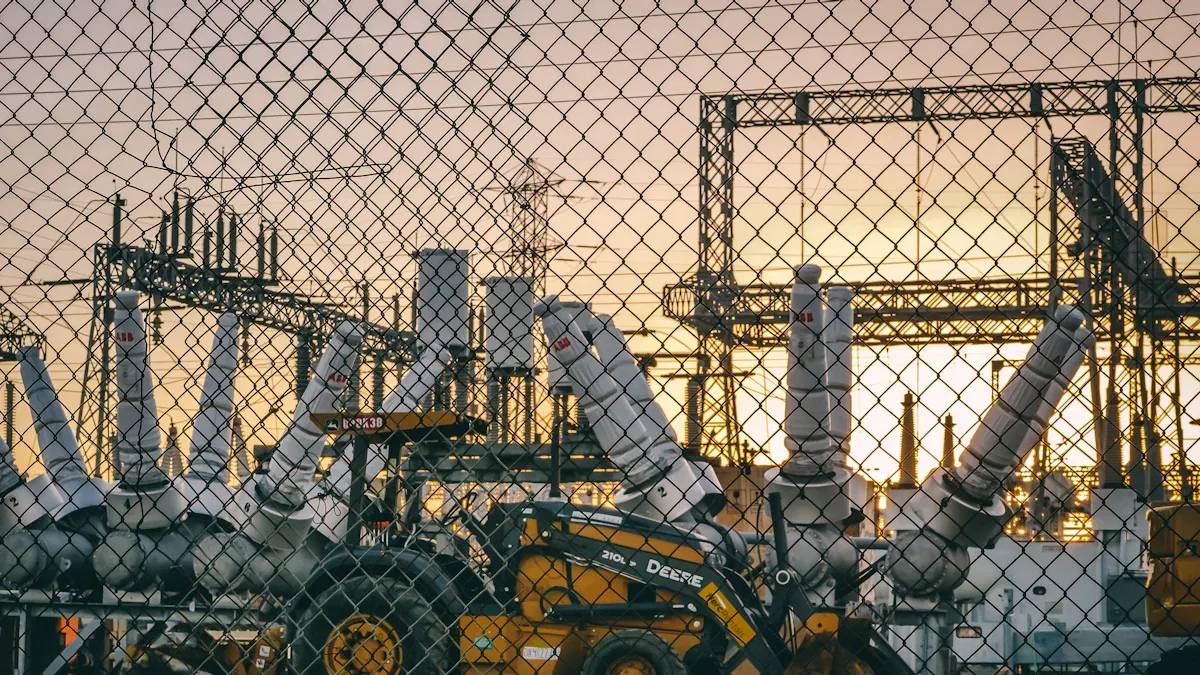Rectifier Modules Explained for Power Systems and Beyond

Rectifier modules are important for changing AC power into DC power. This helps provide steady electricity for many uses. You can find them in things like home gadgets and factory machines. They are very useful because 36% of EV chargers and 31% of solar inverters use fast diodes to save energy. The rectifier market is growing fast. It might go from $6.92 billion in 2024 to $9.75 billion by 2032. Many industries, like cars, green energy, and telecom, need them more and more.
Key Takeaways
Rectifier modules change AC power into DC power. This gives steady electricity for many devices and systems.
There are different rectifiers, like half-wave and full-wave. Each type works for specific needs. Pick one based on how much power you need.
New rectifiers are smarter with IoT features. They let you check power in real-time and save energy.
Rectifiers are important in green energy systems. They turn AC from solar or wind into DC power we can use.
Choosing the right rectifier helps devices work better. It saves energy, lowers costs, and makes systems more reliable.
What Are Rectifier Modules?
Definition and Purpose
Rectifier modules change alternating current (AC) into direct current (DC). This is important because many devices need steady DC power to work. These modules use diodes, which let electricity flow in one direction. This makes the AC-to-DC conversion smooth and reliable. Rectifier modules come in types like half-wave, full-wave, or three-phase. Examples include vacuum tube diodes and silicon-controlled rectifiers, used in many industries.
Rectifier modules do more than just convert AC to DC. They make sure the output power is stable for sensitive devices. From home gadgets to big power systems, they keep things running smoothly. They are built to handle small or large power needs, from tiny electronics to big machines.
Classification Criteria | Description |
|---|---|
Input Supply | Single-phase works with normal AC; three-phase handles more power. |
Conversion Method | Uses both AC halves for steady DC output. |
Control Mechanism | Diodes for basic use; SCRs for controlled versions. |
Importance in Power Systems and Beyond
Rectifier modules are key in power systems. They provide steady DC power, helping grids and machines work well. For example, in power transmission, rectifiers turn AC into DC for long distances. This saves energy and boosts efficiency. They also improve power factor, cutting energy costs and waste.
Outside power systems, rectifiers are used in telecom, green energy, and electronics. Telecom rectifiers give DC power to networks for smooth service. In green energy, they turn AC from wind or solar into DC for batteries. Electronics like laptops and phones use rectifiers to charge and work properly.
Metric | Description | Impact on Efficiency |
|---|---|---|
Power Factor | Real power compared to total power. | High power factor saves energy and cuts waste. |
Total Harmonic Distortion | Measures how clean the output is. | Low THD means better performance. |
Ripple Voltage | Changes in DC output after conversion. | Low ripple gives stable power. |
Load Regulation | Keeps voltage steady with changing loads. | Protects devices from voltage swings. |
Line Regulation | Keeps voltage steady with input changes. | Ensures reliable power in tough conditions. |
By improving reliability, rectifiers help modern technology grow. Their flexibility makes them essential in many fields.
How Does a Rectifier Module Work?
The Rectification Process
Rectification changes AC power into DC power. This is important because devices like phones need steady DC power. Rectifiers do this by letting electricity flow in one direction only. They block electricity from going backward.
There are two main types of rectification: half-wave and full-wave. Half-wave uses one part of the AC wave, making bumpy DC power. Full-wave uses both parts of the wave, giving smoother DC power. For example, a special full-wave rectifier works well at low frequencies, like 10 Hz. But it becomes less efficient at higher frequencies, like above 100 kHz.
The AC signal's shape and frequency affect rectification. Different wave shapes, like sinusoidal or triangular, give different results. To make cleaner DC power, rectifiers use low-pass filters. These filters remove extra ripples from the converted power.
Components of a Rectifier Module
A rectifier module has parts that work together to change AC to DC. The diode is the most important part. Diodes let electricity flow in one direction only. Advanced rectifiers may use special devices like SCRs for better control.
Transformers are also key parts. They change the AC voltage to match what the device needs. For example, step-down transformers lower high voltage to safer levels. Capacitors help smooth the DC power by reducing ripples. Sometimes, inductors are added to make the current more stable.
Modern rectifiers often have heat sinks to cool them down. This stops them from overheating and keeps them working well. Some advanced modules also have control circuits. These circuits adjust the output to keep it steady, even if the load changes.
By using these parts, rectifier modules provide reliable AC to DC conversion. They are essential for power systems and electronic devices.
Types of Rectifier Modules

Rectifier modules come in various types for different needs. Knowing these types helps you pick the right one.
Half-Wave Rectifiers
A half-wave rectifier is the simplest kind. It uses one diode to change alternating current (AC) into direct current (DC). This type only lets the positive part of the AC wave pass. The negative part is blocked. Because of this, the output has many ripples and is not smooth.
Half-wave rectifiers are used in small devices where efficiency is less important. For example, they are found in basic battery chargers or simple circuits. But their low efficiency and high ripples make them bad for devices needing steady DC power.
Metric | Half-Wave Rectifier | Full-Wave Rectifier |
|---|---|---|
Output Waveform | Positive half-cycle only | Both halves used |
Average DC Output Voltage | Lower average voltage | About 0.637Vmax of peak voltage |
Ripple Frequency | Same as input frequency | Double the input frequency |
Efficiency | Lower efficiency | Higher efficiency |
Peak Inverse Voltage (PIV) | Rated for peak AC voltage | Rated for peak AC voltage |
Ripple Factor | Higher ripple | Lower ripple |
Transformer Utilization Factor (TUF) | Lower TUF | Higher TUF |
Full-Wave Rectifiers
A full-wave rectifier is better than a half-wave one. It uses both parts of the AC wave. Usually, it has two diodes and a center-tapped transformer. This design gives smoother DC output with fewer ripples. The ripple frequency is twice the input AC, making it easier to filter.
Full-wave rectifiers are more efficient than half-wave ones. They are used in medium-power devices like electronic power supplies. If you need a steady and efficient rectifier, a full-wave rectifier is a great option.
Bridge Rectifiers
A bridge rectifier improves the full-wave design. It uses four diodes in a bridge shape. This removes the need for a center-tapped transformer. It is smaller and costs less. Like full-wave rectifiers, it changes both parts of the AC wave into DC.
Bridge rectifiers are very efficient and flexible. They are used in many areas, from factory systems to home electronics. They can handle more power, making them perfect for tough jobs.
Tip: When choosing a rectifier, think about efficiency, ripples, and power needs.
Controlled and Uncontrolled Rectifiers
Rectifiers are grouped as controlled or uncontrolled. This depends on how their output is managed. Knowing the difference helps pick the right one.
Uncontrolled Rectifiers
Uncontrolled rectifiers use diodes to change AC into DC. Diodes let current flow in one direction only. This makes the process automatic and simple. You cannot change the output voltage or current in these rectifiers. They are cheap, reliable, and easy to use. But they are not flexible.
These rectifiers work well when steady DC power is enough. For example, they are used in battery chargers and small gadgets. Their simple design makes them easy to fix. However, they are not good for systems needing adjustable output.
Controlled Rectifiers
Controlled rectifiers use devices like SCRs instead of diodes. SCRs let you control when current flows by changing the firing angle. This allows you to adjust the output voltage and current.
These rectifiers are more advanced but offer better control. They are used in systems needing precise DC power control. For example, they are found in factory machines, motor drives, and green energy setups. Controlled rectifiers are great for jobs needing variable power.
Feature | Uncontrolled Rectifiers | Controlled Rectifiers |
|---|---|---|
Key Component | Diodes | SCRs |
Output Control | Fixed | Adjustable |
Complexity | Simple | Complex |
Applications | Small devices | Industrial systems |
Tip: Choose an uncontrolled rectifier for simple needs. Pick a controlled rectifier for advanced systems needing flexibility.
Applications of Rectifier Modules

Rectifier modules are important in many industries. They provide steady DC power by changing AC into DC. This makes them very useful in modern technology. Let’s look at how they are used in power systems, telecom, and renewable energy.
Power Systems
In power systems, rectifier modules help convert and deliver power efficiently. They change AC into DC for long-distance transmission, saving energy. This makes them vital for high-voltage direct current (HVDC) systems. Rectifiers also improve power factor and reduce harmonic distortion, making power grids work better.
Modern rectifiers perform very well in power systems. For example:
Metric | Value |
|---|---|
Peak Efficiency | 97.83% |
Voltage for Peak Efficiency | 277 VAC |
Full Load Efficiency (min) | Above target |
These numbers show how reliable and efficient rectifiers are. They handle different loads and keep voltage steady. This ensures a constant power supply for important uses.
Note: Using rectifiers in power systems saves energy and lowers costs.
Telecom Rectifiers
Telecom rectifiers power communication networks. They give steady DC power to servers, base stations, and 5G systems. This keeps networks running smoothly. With up to 96% efficiency, they save energy and reduce waste.
Main features of telecom rectifiers include:
High Efficiency: They change AC to DC with little energy loss.
Safety Features: Systems check voltage and temperature to avoid problems.
Compact Size: Their small design fits tight spaces easily.
Telecom rectifiers meet the needs of modern networks. They provide steady DC power even during power changes. This is crucial for keeping networks online and supporting heavy data use.
Tip: When choosing a telecom rectifier, check its efficiency, safety, and compatibility.
Renewable Energy Systems
Renewable energy systems use rectifiers to change AC from wind or solar into steady DC. This DC power is stored in batteries or used directly. Rectifiers make renewable energy systems more reliable and efficient.
For example, in solar systems, rectifiers turn AC from inverters into DC for storage. This ensures steady DC power for homes and businesses. In wind systems, rectifiers handle changing AC from turbines, giving consistent DC power.
Rectifiers help renewable energy systems support cleaner energy. They improve energy conversion and storage, cutting carbon emissions and promoting sustainability.
Did You Know? Rectifiers in renewable energy systems can handle wide voltage ranges, making them flexible for different sources.
Consumer Electronics
Rectifier modules are key for making electronics work well. They give devices the steady DC power they need to run. Gadgets like phones, laptops, and TVs depend on rectifiers. These convert AC from outlets into usable DC power.
How Rectifiers Work in Consumer Electronics
When you plug in a device, the rectifier changes AC to DC. This DC power is needed for sensitive parts inside. For example, your phone charger has a rectifier. It helps charge your battery safely and efficiently. TVs also use rectifiers to keep power steady and avoid flickering.
Common Applications in Consumer Electronics
Rectifiers are used in many electronics. Here are some examples:
Smartphones and Tablets: Chargers use rectifiers to safely convert AC to DC.
Laptops: Adapters have rectifiers to give stable DC power.
LED Lighting: Rectifiers provide the right DC voltage for steady light.
Gaming Consoles: They ensure stable power for smooth gaming performance.
Benefits of Rectifiers in Electronics
Rectifiers offer many benefits for electronics:
Longer Device Life: Stable DC power protects parts from damage.
Energy Saving: Modern rectifiers waste less energy during conversion.
Small Size: Compact rectifiers fit well in portable gadgets.
Did You Know? Without rectifiers, your favorite gadgets wouldn’t work as well or last as long.
Rectifiers are crucial for electronics. They keep devices running smoothly and reliably, making them essential in today’s technology.
Advancements in Rectifier Technology
High-Efficiency Rectifier Modules
Modern rectifiers are now more efficient due to new technologies. Better packaging methods, like COB and DCA, help manage heat. These methods cut energy loss and allow smaller designs. This means higher power and better reliability. Digital controls also improve performance. They make rectification precise, even when loads change. This reduces wasted energy and keeps the DC output steady.
Another cool improvement is adding IoT connectivity. With IoT, you can check rectifiers from anywhere. This helps avoid downtime and keeps systems running smoothly. These upgrades save energy and lower costs. High-efficiency rectifiers are a great choice for modern needs.
Smart System Integration
Rectifiers are getting smarter with IoT features. You can monitor voltage, temperature, and energy use in real time. This helps find problems early and prevents failures. Smart rectifiers also adjust power automatically to match the load. This keeps DC power steady, even when conditions change.
These smart systems are helpful in telecom and green energy. For example, in solar setups, they handle changing sunlight. They improve energy conversion and ensure reliable storage. Smart technologies make rectifiers more efficient and easier to use.
Emerging Trends in Rectifier Design
The future of rectifiers is exciting with new trends. Modular designs are becoming popular. They let you upgrade and expand systems easily. IoT is cutting energy use by up to 20%. Sustainability is also a big focus. Companies now use eco-friendly materials and energy-saving designs.
Renewable energy is increasing the need for advanced rectifiers. Solar and wind systems need rectifiers for changing power inputs. These trends show how rectifiers are key to a greener, more efficient future.
Trend/Forecast | Description |
|---|---|
Modular Designs | Easy-to-upgrade designs for better scalability and flexibility. |
Smart Technologies | IoT reduces energy use by up to 20% with real-time monitoring. |
Sustainability | Eco-friendly materials and designs meet energy-saving rules. |
Renewable Energy Impact | More demand for rectifiers to handle solar and wind power changes. |
Did You Know? Modular rectifiers are easy to upgrade and lower maintenance costs.
Rectifier modules are crucial for changing AC power into DC power. They help devices get steady electricity to work properly. You’ve seen how they work and the types like half-wave, full-wave, and bridge rectifiers. These modules are very important in power systems. They save energy, work efficiently, and support key areas like green energy and telecom.
New technology has made rectifier modules better and smarter. Features like IoT and modular designs improve how they work and adapt. As industries grow, these upgrades keep rectifiers important for today’s power needs and more.
FAQ
1. What does a rectifier module do?
A rectifier module changes alternating current (AC) into direct current (DC). Many devices need DC power to work correctly. Rectifiers give steady and reliable power for electronics, power grids, and green energy systems.
2. How can you pick the right rectifier module?
Think about your power needs and device type. Use an uncontrolled rectifier for simple gadgets. For systems needing adjustable power, pick a controlled rectifier. Always check voltage and current ratings to fit your needs.
Tip: Choose energy-saving models to lower costs and save power.
3. Can renewable energy use rectifier modules?
Yes, rectifier modules work great with renewable energy. They turn changing AC from wind or solar into steady DC. This helps store and use energy efficiently.
4. Why are bridge rectifiers widely used?
Bridge rectifiers are efficient and flexible. They use four diodes to change both parts of the AC wave into DC. This design skips the need for a center-tapped transformer, making them smaller and cheaper.
5. What makes modern rectifiers better?
Modern rectifiers are more efficient, smaller, and smarter. They include features like IoT for better monitoring and energy savings. Modular designs make upgrades easier and improve reliability.
Did You Know? Smart rectifiers with IoT can cut energy waste by 20%.
See Also
Essential Insights Into Telecom Power Supply Systems For Beginners
Telecom Cabinets: Integrating Grid-Connected Inverters And Battery Systems
Calculating Power Systems And Batteries For Telecom Cabinets
A Comprehensive Look At Global Standards For Power Supplies
Key Features Of Telecom Power Supplies You Should Understand
CALL US DIRECTLY
86-13752765943
3A-8, SHUIWAN 1979 SQUARE (PHASE II), NO.111, TAIZI ROAD,SHUIWAN COMMUNITY, ZHAOSHANG STREET, NANSHAN DISTRICT, SHENZHEN, GUANGDONG, CHINA

